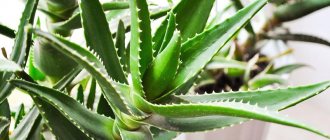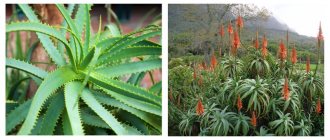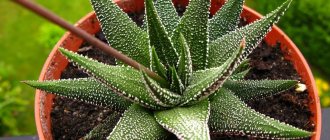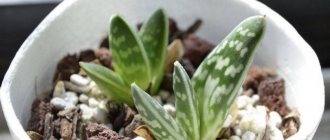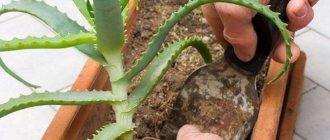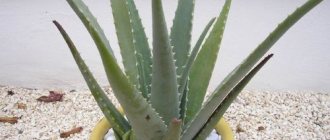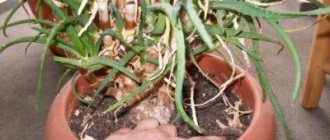Almost the same plant, but outwardly different, are agave (aloe vera) and agave (aloe vera).
Aloe belongs to the group of evergreen crops that are not connected by a single origin. There are about 300 such varieties. The reason for the special classification was the characteristics of each individual subspecies. The most common and easily recognizable among all others are aloe vera and agave.
The latter has a thick trunk with succulent leaves. Agave grows as a bush with wide, lush leaves growing straight up from the center. Moreover, their chemical composition is absolutely the same, as are their rare medicinal properties.
But the external signs vary greatly: aloe vera has a short stem, unlike agave, and thick leaves with a characteristic triangular outline. Agave is different - it resembles a small tree, with fleshy leaves with pointed ends coming straight from the trunk.
Agave leaves are more than thirty centimeters long. No other variety has such a trunk, where leaves grow from the very base. They extend to a maximum height of 50 cm.
Agave, true to its impressive name, has a grayish, dull, unsightly color, which differs from aloe vera, which has a cheerful, juicy bright green color scheme.
What is the difference between these two types?
Only here, however, there is still some difference. Agave is used only for external use, and agave, on the contrary, for internal use. In 1500 BC. A record of aloe was first discovered on ancient papyrus in Egypt. She was found by the German doctor Georg Ebers, a “part-time” writer.
At first, the plant took root in the lands of the South African climate, where dry air and very high temperatures reign. In the wild, both species are found in semi-deserts and deserts, and in the tropical zone.
Then aloe became popular and moved into almost all residential buildings due to its universal ability to treat many diseases at home. Soon it deservedly received the name of a healing “magic wand” - always at hand. Everyone is already accustomed to a certain type of plant on the windowsills of apartments in moderate sizes. In fact, being in a natural habitat, aloe can grow up to 2 or even 3 meters, moreover, it also manages to bloom.
What do aloe and agave look like?
Both of these plants are considered succulents, meaning they have the ability to store water. It is also worth noting that the cactus is a prominent representative of them. To understand the similarity between aloe and agave, you should consider their appearance and biological description.
- The fact is that experts today count more than 400 species of aloe. Most often, only 2 types are used - aloe vera and aloe vera. Aloe spinous and variegated can be used for decorative purposes.
- Aloe looks more like a bush with wide leaves. There are often spines or thorns at the ends. More precisely, this is what real Barbados aloe looks like, which is considered the most valuable plant of all its species.
Real aloe has a bush shape and wide leaves.
- Ornamental bushes, which are significantly inferior in terms of the content of fleshy pulp and the strength of beneficial properties, are either smaller in size or lack thorns. There are even aloe in the form of a real giant tree, such as Aloe Pilans or Baynes.
- But another type of aloe requires our attention, which is also popular in local latitudes - tree aloe. It is shaped like a tree, but small. That is, it has a trunk from which leaves spread. By the way, this species often grows in our latitudes. It is he who will receive the popular name of the agave.
Important: Therefore, we can say with confidence that agave and aloe are the same plant . You just need to be extremely careful, because this only applies to aloe vera. In other words, agave and aloe are different species of the same plant . Therefore, there are similarities and even some differences between them.
Agave or aloe vera has the shape of a tree
Useful and healing properties of Aloe
- The chemical composition is amazing in the amount of useful microelements that help improve external and internal organs.
- A whole complex of vitamins is hidden in the plant: B12, B6, B2, B9, B1; A, E, C. Minerals: calcium, selenium, copper, sodium, chromium, potassium.
- Aloe with its beneficial properties destroys intestinal, dysentery bacilli and streptococci.
- Contains enzymes, poly- and monosaccharides, amino acids, antioxidants, salicylic acid.
You will also be interested in How to distinguish a boy cat from a cat - the difference between the sexes of kittens
Agave and aloe vera: what is the difference
Tree-like aloe differs from its wild relatives only in size. Otherwise, these are absolutely identical plants: the leaves with spines are widely spaced from each other, directed in different directions, the stem is clearly defined. Aloe vera leaves are collected in a bunch, growing upward, the stem is difficult to see.
The root system is practically undeveloped. The leaves of both types are green-gray, smooth and fleshy, with serrated edges. Houseplants bloom in winter. Bright orange bells appear on the plant.
Properties of pulp and juice
Valuable juice and pulp are obtained from aloe. To do this, you need to pick only the lower succulent leaves, the thickest ones, with a dried tip, in which all the necessary substances have already accumulated. But that's not all. Immediate use is not recommended.
To enhance the therapeutic effect, you should first put the cut leaf in the refrigerator for a week. Only then, after taking it out, rinse with boiled, slightly warm water. Next, carefully cut off the thin green skin to reveal the plant pulp necessary for use.
Forms of medicines based on aloe
Leaves and condensed juice of aloe, obtained by evaporation, are used as medicinal raw materials. The latter is also called “sabur”, which is translated from Arabic as “patience”, because aloe itself, due to its ability to go without water for a long time, is considered a symbol of endurance. Leaves are collected several times a year, selecting only the lower and middle ones, at least 15 cm long. Before harvesting, the plant is not watered for several weeks so that the concentration of nutrients increases as much as possible. Active components are stored for 4 hours after collection.
There are three types of raw materials: fresh leaves, dry leaves and fresh shoots. Aloe extract from fresh leaves is used in medicine and cosmetology.
It is also important to distinguish between aloe gel and aloe juice. Juice
is a yellowish liquid contained in the leaves and released when they are cut or broken, and
the gel
is the processed pulp of the leaves. Aloe juice is more concentrated and rich in active substances, but both forms are used in pharmaceuticals and cosmetology.
Application and use of agave
Where and how should this “home doctor” be used correctly:
- When healing cuts and wounds.
- For bites of various insects.
- Perfectly draws out pus, including from boils.
- Get rid of unwanted dandruff, generally help restore hair follicles for hair growth.
- Promotes the healing of ulcers, also with eczema and psoriasis.
- Phlebeurysm.
- Smoothes wrinkles and improves complexion.
- Allatoin helps retain moisture in the skin.
Medicinal properties
Both plants have pronounced healing properties, which in some way duplicate each other. However, most adherents of traditional medicine still consider aloe vera to be a more useful plant in a medicinal sense. At the same time, supporters of the agave claim and scientifically prove that this plant contains more useful minerals and natural biostimulants.
Professional pharmacists do not divide these plants into more or less useful ones, but recognize the outstanding healing qualities of both. Next, we will consider what beneficial medicinal properties both types of aloe have, and whether there is a difference between these properties.
Agave
- Lotions with the juice of this plant are able to draw pus from boils and help the latter to heal quickly.
- The juice is also useful after insect bites, it can pacify itching and other unpleasant sensations, and soothe the skin.
- Agave has very useful qualities in healing cuts, wounds and abrasions.
- The juice of the plant helps to strengthen hair follicles and can protect to some extent from hair loss. In addition, it helps get rid of dandruff and makes the scalp healthier and cleaner. Using this natural biomaterial, you can also accelerate hair growth.
- Agave juice is also used in cosmetology - it improves complexion and helps smooth out fine wrinkles. In addition, the juice perfectly moisturizes.
- The plant is used for varicose veins. By lubricating the affected areas with the juice of the plant, you can relieve tired legs, make the veins stronger, and eliminate swelling.
- Agave is also used as a healing agent for ulcers, eczema, and psoriasis. Can also be used for other skin diseases.
- The plant has pronounced bactericidal and disinfecting properties. This quality has long been noticed among the people, which is why agave juice is a popular antimicrobial agent. The juice of the plant will help quickly heal burns and heal all kinds of wounds of any origin.
If you take the bitter juice of the plant (diluted) internally, you can protect yourself from loss of strength, including seasonal ones. If a man has sexual impotence, the juice of the plant will help cope with this delicate problem.
In cool weather, the plant can become a real salvation for the whole family from colds, flu and other seasonal misfortunes. Agave is famous for its ability to strengthen the immune system.
Important: most doctors and traditional healers agree that agave juice is best used externally.
Aloe vera
The use of this plant as a medicine was first mentioned in ancient Egyptian papyri. In these historical documents, scientists have found as many as 12 ways to use the plant as a medicine. It is better to use the juice and gel filler of aloe vera leaves internally - this method is more effective. Next are the healing properties.
- Aloe vera juice and pulp help strengthen the cardiovascular system.
- The juice is also useful for restoring and strengthening gums. Those who have experienced periodontal disease will certainly appreciate this useful quality.
- Aloe vera is useful for activating the urinary organs.
- The juice and pulp of the plant strengthen the immune system, can become real helpers in winter, and relieve colds and other contagious respiratory diseases.
- The plant will also be appreciated by people with diabetes. Aloe vera juice, taken orally, lowers blood sugar levels in a natural, gentle way.
- The plant protects against heartburn, including during pregnancy, and prevents intestinal disorders.
- For arthritis patients, aloe vera juice is also very useful, as it can relieve pain associated with this joint disease. In addition, the juice relieves inflammation in the affected area.
- The plant can help heal microcracks in the skin, activate epidermal renewal and rejuvenation.
Using the juice of the plant, you can saturate the body with essential vitamins and other beneficial substances. It can also eliminate problems with the stomach and intestines, relieve joint pain, make the blood composition cleaner and healthier, get rid of infections of various natures, and help heal wounds and ulcers.
The plant juice has pronounced disinfecting properties and is able to fight most pathogenic bacteria, including:
- streptococci;
- coli;
- dysentery bacillus;
- staphylococci.
Using aloe vera juice and pulp, you can prepare homemade cosmetic potions for hair and skin. The plant is also used as an effective and mild laxative and choleretic drug.
The plant contains a wide range of valuable vitamins and minerals: A, C, E, almost complete group B, calcium, selenium, potassium, copper, chromium, sodium, magnesium. In addition to the listed components, the composition also contains bioenzymes, amino acids, anthraglycosides, antioxidants, saccharides, phytoncides and healthy steroid compounds of natural origin.
Uses of aloe vera plant
In terms of chemical composition, agave is in no way inferior to agave, but doctors say that the result will be better if the juice or pulp is used internally. The plant works wonders for the following problems:
- When restoring gums.
- Strengthens the entire cardiovascular system.
- Regulates blood sugar levels.
- Strengthens the overall immune system.
- The functioning of the urinary canals improves.
- Dulls pain and inflammation in arthritis. Eliminates digestive disorders and heartburn.
How to care
Aloe is an unpretentious plant, but there are some rules that should be followed so that it does not disappear.
- place on the sunny side;
- Unroll it regularly so that the leaves grow evenly;
- do not leave in the cold;
- water generously, but remove excess water from the pan;
- replant once every 3 years;
- the soil should consist of sand, earth and turf.
To replant the plant, you need to leave the cuttings in water for several days. There it will quickly take root. Then transplant the aloe into the soil.
Conclusion
So, both types of medicinal plants under consideration are very similar to each other. The only differences are:
- External factors.
- Areas of application.
- Contraindications.
It is simply necessary to grow these affordable healers in your home, since they are quite unpretentious in care, and will come to the rescue in any situation that arises. Well, which of the two plants to choose as a permanent home healer depends solely on personal needs and health problems.
Watch the video in which the author from the “Love for Life” channel will tell you more about the distinctive features of plants.
Differences in plant care
@flowersfamily.ru
Both plants are unpretentious, which is why they often settle even in the homes of people who are not very keen on floriculture. However, agave is popular precisely because of its healing properties, while aloe vera captivates with its slightly more decorative properties.
Both varieties are propagated by planting root shoots or rooting cuttings (leaves). These plants can also be rejuvenated by cutting and rooting the top. But if the agave can still recover after such a procedure by sprouting young shoots, then aloe vera dies after cutting off the top.
Another difference is the greater unpretentiousness of the agave. Aloe vera needs to be watered and fed a little more often. However, the rest of the care for these plants is identical.
ATTENTION!
The information on the site is for informational purposes only and does not call for action. Remember, self-medication can harm your health. Before using medicinal herbs, consult your doctor.
Aloe juice and gel
The composition of these natural substances is unique, they include:
- anthraglycosides;
- enzymes;
- minerals calcium, zinc, iron, lithium, selenium;
- steroid compounds;
- phytoncides;
- vitamins C, PP, group B, tocopherol, carotene.
The juice has an antimicrobial, choleretic, anti-inflammatory, regenerating effect. Aloe extract is an effective medicinal product, used by official medicine in the treatment of pathologies of the digestive system, musculoskeletal system, visual organs, respiratory organs, and skin diseases. The pharmaceutical industry produces:
- sabur - condensed juice, used both internally and externally;
- injection extract in ampoules;
- syrup;
- aloe tablets;
- eye drops.
The cosmetic properties of aloe are also wide. The ability to heal microcracks, relieve irritation, and stimulate the growth of new cells allows its components to be used in the production of skin and hair care products. The gel in the pulp of the leaves, which has a softening and anti-inflammatory effect, is added to lotions, shampoos, creams and balms.
What is the difference between aloe and aloe vera photo
From numerous photos you can easily trace the main difference between agave and aloe vera. The external description of both specimens begins with the characteristics of the stem. Agave, a photo of which is easy to find, has a thick trunk. The trunk can stretch up to several meters. The sword-shaped leaves are 60 cm long and have jagged edges with sharp spines.
Due to the accumulation of moisture, the leaves increase in thickness, but during prolonged drought their size decreases due to the consumption of liquid. Agave in the wild blooms with large tubular red, yellow or orange flowers, collected in a multi-flowered raceme.
The second representative forms a rosette of leaves from the very surface of the soil. It doesn't have a trunk. The edges of the leaves have spines characteristic of the genus, the thickness of the leaves depends on external factors. This is the basic answer to the question of what is the difference between aloe and aloe vera.
